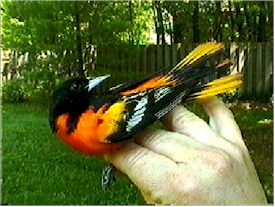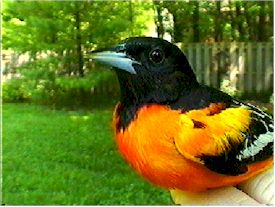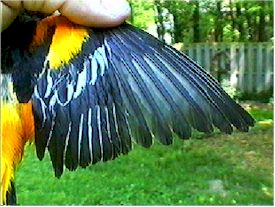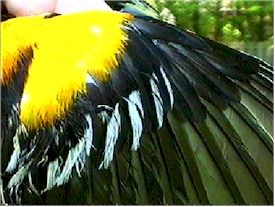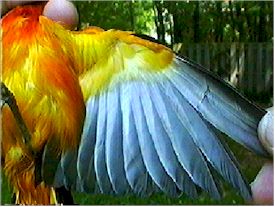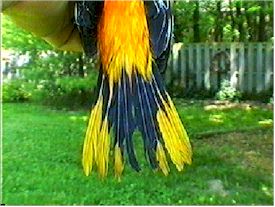Baltimore Oriole
(Icterus galbula)
The attractive Baltimore Oriole, a bird of open woods and shade trees, is one of the 9 species of Orioles that occur in the USA. Most spend their winters in Central and South America, but breed in the Eastern USA and Canada. The Baltimore Oriole is closely related to the more western Bullock’s Oriole, and these two species readily interbreed where their ranges overlap in the great plains states. Their deliberate whistles and chattering sounds high in the treetops signal the arrival of spring.
The Baltimore Oriole is from 7 to 8 inches long with a wingspan of 11.25 to 12.25 inches. Weights range from 1 to nearly 2 ounces.
Figure 1 - Baltimore Oriole - Male
Figure 2 - Baltimore Oriole - Male
The adult male is flame-orange and black with a solid black head. The female is olive-brown above with a burnt orange underside. Immature males have a brownish to blackish head but otherwise look much like the female, and do not obtain the solid black head and adult plumage until their second year.
The black wing has nine primary flight feathers, a distinctive white wing bar and white edging to the secondary and tertial feathers.
Figure 3 - Baltimore Oriole Upper Wing
Figure 4 - Baltimore Oriole Coverts
The shoulder has a bright flame-orange patch. White outer edges on the greater coverts make up the white wing bar.
The breast, flank, belly and underwing coverts are also flame-orange.
Figure 5 -Baltimore Oriole Under Wing
Figure 6 - Baltimore Oriole Rump & Tail
The rump and tail feathers also show the bright flame-orange coloration.
Nesting Behavior
The nest, built mostly by the female, is a swinging pouch about 6 inches long suspended at the end of a branch up to 90 feet up. The nest is woven of long plant fibers, vine bark, hair, and sometimes yarn, is lined with hair, wool and fine grasses. Four eggs, incubated by the female, hatch in about two weeks. Both parents care for the young who leave the nest in 12 to 14 days.
Banding Recoveries
The Bird Banding Lab web site reports that between 1955 and 1997, a total of 82,331 Northern Orioles were banded. Of these, 748 have been recovered, a recovery rate of 0.91%.
Banding studies show that Baltimore Orioles are short to long distance migrants, and can live up to 7 years in the wild, and up to 14 years in captivity.
If you should recover a banded bird, please report the band number to the Bird Banding Lab by calling 1-800-327-BAND.
Conservation Status and Economic Importance
The Baltimore Oriole’s diet consists of caterpillars, webworms, gypsy moths, beetles, ants, grasshoppers, aphids and other insect pests. These birds play an important role in the health of our forests by gleaning destructive insects from trees. The diet also consists of fruits and nectar, and they will readily come to hummingbird feeders and halved oranges.
Although common, populations seem to be declining across North America. Human hazards such a collisions with buildings, towers, cars, and windows certainly take their toll along with loss of habitat in their wintering grounds.
